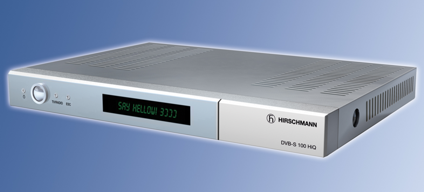DVB satellite (DVB-S)
The transmission standard for digital TV via satellite introduced in 1994 is called DVB-S. DVB-S is broadcast by various telecommunications satellites on the satellite frequencies between 10.7 GHz and 12.75 GHz, such as Astra and Eutelsat. Conceptually, DVB-S operates as a broadcast service for the transmission of digital TV and digital broadcasting, but like all other DVB systems, it also offers a return channel for the use of interactive distribution services.
The available frequency range of 2 GHz is used in two polarization planes and can transmit a total of 200 transponder channels at a channel bandwidth of 40 MHz.
The bandwidths of DVB-S
DVB-S can operate with transponder bandwidths between 26 MHz and 54 MHz. At a bandwidth of 33 MHz, a maximum of 24.44 MSymbols/s can be transmitted. If each symbol consists of two bits, this results in a gross data rate of 48.88 Mbps. For the net data rate, coding and error protection must still be taken into account. Depending on the effort involved, the net data rates at 26 MHz bandwidth are between 17.8 Mbit/s and 31.1 Mbit/s, at 36 MHz bandwidth between 22.5 Mbit/s and 39.4 Mbit/s, and at 54 MHz bandwidth a maximum of 64.5 Mbit/s is achieved. All of the above data rates are perfectly adequate for HDTV in the highest resolution.
The modulation technology of DVB-S
DVB-S is modulated in quadrature phase shift keying( QPSK), has a frame length of 204 bytes and a Reed-Solomon code of 204/188, which will later be replaced by a convolutional code. Data transmission uses forward error correction( FEC) with a code rate of 3/4, meaning that there are four code bits for every three bits of information.
The same transponders are also used for DVB-S radio. Depending on the service, digital broadcasting is transmitted at 192 kbit/s ( mono) and at 256 kbit/s or 320 kbit/s for stereo sound. Surround sound in Dolby Digital will operate at 448 kbit/s, resulting in much improved sound quality.
The pure broadcast transmission will be extended by back channels. The return channel system in DVB-S is called DVB-RCS and can be used for teleshopping or telelearning.
In 2005, an improved DVB-S version with higher data rates, DVB-S2, was standardized under the European standard EN 302307.


